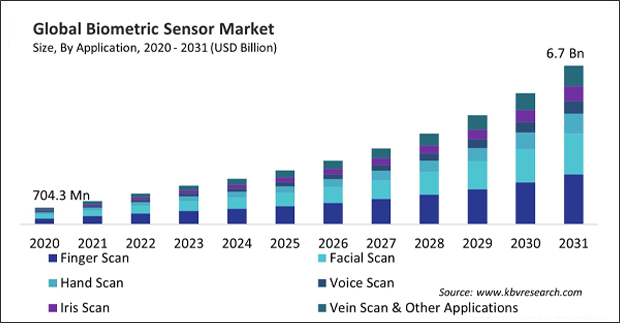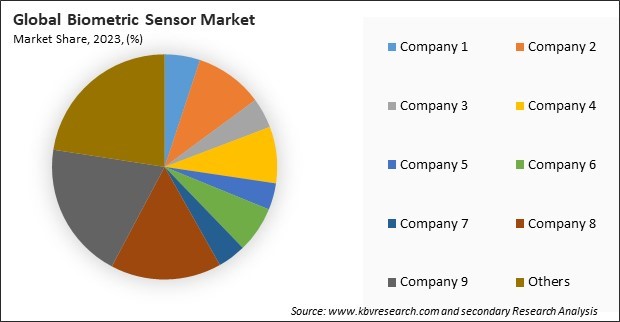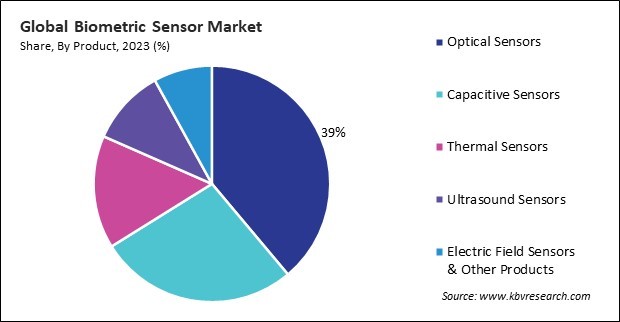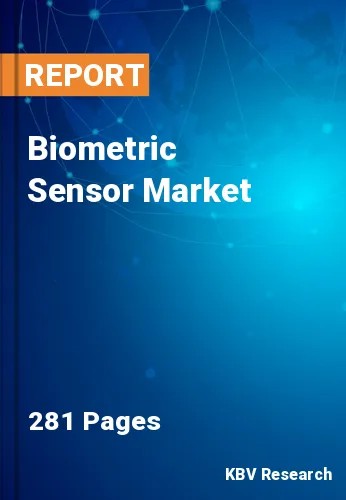“Global Biometric Sensor Market to reach a market value of 6.7 Billion by 2031 growing at a CAGR of 19.5%”
The Global Biometric Sensor Market size is expected to reach $6.7 billion by 2031, rising at a market growth of 19.5% CAGR during the forecast period.
Facial recognition technology has gained significant traction in both commercial and security applications. The ability to identify individuals based on unique facial features makes it an ideal choice for surveillance, border control, and personalized user experiences in devices like smartphones and laptops. Advances in artificial intelligence and machine learning have further enhanced the accuracy and reliability of facial scan systems, contributing to their growing popularity in the biometric sensor market. Thus, in 2023, the facial scan segment attained 25% revenue share in the biometric sensor market.

The demand for enhanced security solutions has significantly driven the biometric sensor market. With the increasing sophistication of cyber threats and frequent data breaches, traditional security measures such as passwords and PINs are becoming insufficient. Additionally, Biometric authentication is gaining traction across various industries due to its reliability and convenience. In consumer electronics, devices like smartphones and laptops are increasingly equipped with biometric sensors, such as fingerprint scanners and facial recognition systems. These features provide users with quick and secure device access, enhancing user experience and satisfaction. Therefore, the increasing adoption of biometric authentication across industries drives the market's growth.
However, one major constraint in the biometric sensor market is the high initial cost associated with implementing these systems. Biometric sensors require advanced technology and specialized hardware, which can be expensive to develop and integrate into existing systems. This high upfront cost can be a significant barrier for small and medium-sized enterprises (SMEs) and even some larger organizations with limited budgets, making it difficult for them to adopt biometric solutions despite their benefits. Therefore, the high initial costs of biometric sensor systems are hampering the market's growth.

The leading players in the market are competing with diverse innovative offerings to remain competitive in the market. The above illustration shows the percentage of revenue shared by some of the leading companies in the market. The leading players of the market are adopting various strategies in order to cater demand coming from the different industries. The key developmental strategies in the market are Acquisitions, and Partnerships & Collaborations.
By end use, the market is divided into consumer electronics, construction, defense, medical, BFSI, and others. In 2023, the consumer electronics segment registered 36% revenue share in the bioetric sensor market. Biometric sensors are widely used in consumer electronics, particularly smartphones, laptops, and wearable devices, for fingerprint scanning, facial recognition, and voice authentication.
Based on product, the market is divided into optical sensors, capacitive sensors, thermal sensors, ultrasound sensors, electric field sensors, and others. In 2023, the thermal sensors segment held 15% revenue share in the market. Thermal sensors are used to capture the unique heat patterns of an individual, which are difficult to replicate.

On the basis of application, the market is segmented into finger scan, facial scan, hand scan, voice scan, iris scan, vein scan & others. The hand scan segment witnessed 12% revenue share in the market in 2023. Hand scanning, which typically analyzes the shape and size of the hand and the patterns of veins and fingerprints, is increasingly used in high-security environments.
Free Valuable Insights: Global Biometric Sensor Market size to reach USD 6.7 Billion by 2031
Region-wise, the market is analyzed across North America, Europe, Asia Pacific, and LAMEA. In 2023, the Europe region generated 31% revenue share in the market. Europe is home to diverse industries increasingly adopting biometric sensors for security and efficiency purposes, such as banking, healthcare, and government services.
| Report Attribute | Details |
|---|---|
| Market size value in 2023 | USD 1.6 Billion |
| Market size forecast in 2031 | USD 6.7 Billion |
| Base Year | 2023 |
| Historical Period | 2020 to 2022 |
| Forecast Period | 2024 to 2031 |
| Revenue Growth Rate | CAGR of 19.5% from 2024 to 2031 |
| Number of Pages | 274 |
| Tables | 430 |
| Report coverage | Market Trends, Revenue Estimation and Forecast, Segmentation Analysis, Regional and Country Breakdown, Market Share Analysis, Porter’s 5 Forces Analysis, Company Profiling, Companies Strategic Developments, SWOT Analysis, Winning Imperatives |
| Segments covered | Product, Application, End Use, Region |
| Country scope |
|
| Companies Included | Synaptics Incorporated, NEC Corporation, HID Global Corporation (Assa Abloy AB), Fujitsu Limited, 3M Company, Infineon Technologies AG, M2SYS Technology, Inc., Aware, Inc., Thales Group S.A. and IDEMIA SAS (Advent International, Inc.) |
By Product
By Application
By End Use
By Geography
The Market size is projected to reach USD 6.7 billion by 2031.
Rising demand for enhanced security solutions boosting market demand are driving the Market in coming years, however, High initial costs of biometric sensor systems restraints the growth of the Market.
Synaptics Incorporated, NEC Corporation, HID Global Corporation (Assa Abloy AB), Fujitsu Limited, 3M Company, Infineon Technologies AG, M2SYS Technology, Inc., Aware, Inc., Thales Group S.A. and IDEMIA SAS (Advent International, Inc.)
The expected CAGR of this Market is 19.5% from 2024 to 2031.
The Finger Scan segment is leading the Market by Application in 2023; thereby, achieving a market value of $2.3 billion by 2031.
The North America region dominated the Market by Region in 2023, and would continue to be a dominant market till 2031; thereby, achieving a market value of $2.3 billion by 2031.
Our team of dedicated experts can provide you with attractive expansion opportunities for your business.

 Drivers
Drivers
 Restraints
Restraints
 Opportunities
Opportunities
 Challenges
Challenges
